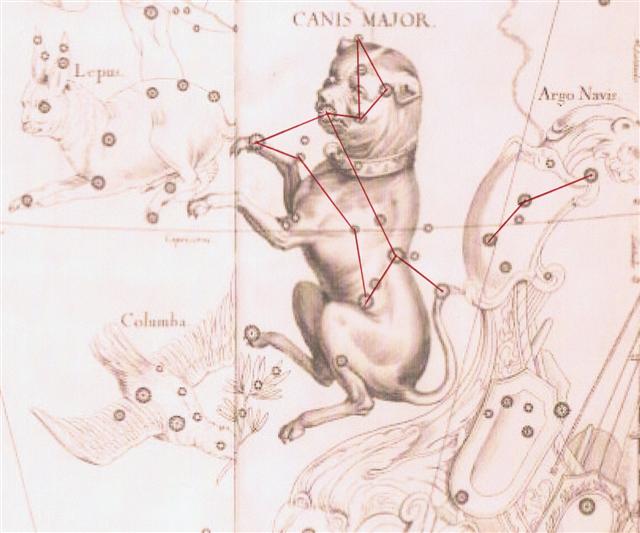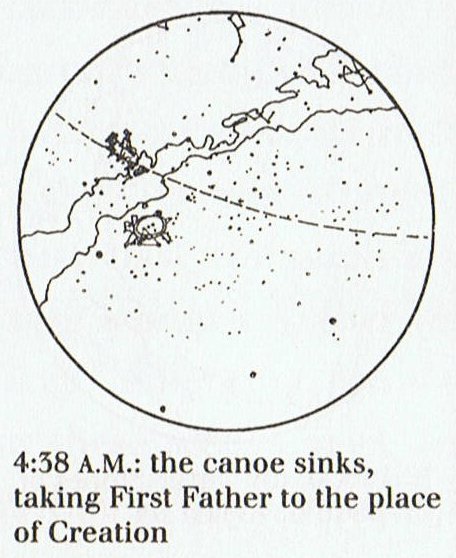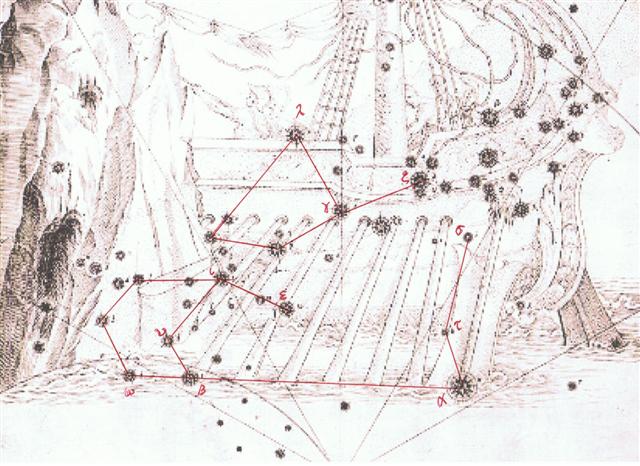|
THE D TABLET
Argo Navis was towed along by Canis Major, presumably represented by Sirius and the Great Dog's nose: ... The Ship appears to have no bow ... Aratos wrote: Sternforward Argō by the Great Dog's tail // Is drawn; for hers is not a usual course, // But backward turned she comes, as vessels do // When sailors have transposed the crooked stern // On entering harbour; all the ship reverse, // And gliding backward on the beach it grounds. // Sternforward thus is Jason's Argō drawn. This loss of its bow is said to have occurred ... when Argō pass'd // Through Bosporus betwixt the justling rocks - the Symplegades, the Cyanean (azure), or the Planctae Rocks at the mouth of the Euxine Sea. Yet Aratos may have thought it complete, for he wrote: All Argō stands aloft in sky. and Part moves dim and starless from the prow // Up to the mast, but the rest is bright; and it has often be so illustrated and described by artists and authors ...
... In Greek mythology, the Symplegades, also known as the Cyanean Rocks or Clashing Rocks were a pair of rocks at the Bosporus that clashed together randomly. They were defeated by Jason and the Argonauts, who would have been lost and killed by the rocks except for Phineas' advice. Jason let a dove fly between the rocks; it lost only its tail feathers. The Argonauts rowed mightily to get through and lost only part of the stern ornament. After that, the Symplegades stopped moving permanently. The Romans called them cyaneae insulae ... Maybe Argo Navis eventually once upon a time had lost Sirius because this magnificent star was not standing firm but was instead moving towards dawn in precisely the same way as the Sun (as his mirror image in the night). ... The Sothic cycle was based on what is referred to in technical jargon as 'the periodic return of the heliacal rising of Sirius', which is the first appearance of this star after a seasonal absence, rising at dawn just ahead of the sun in the eastern portion of the sky. In the case of Sirius the interval between one such rising and the next amounts to exactly 365.25 days - a mathematically harmonious figure, uncomplicated by further decimal points, which is just twelve minutes longer than the duration of the solar year ... By the way, the head of Canis Major, I suddenly realize, could possibly have been depicted as one of the signs on the Phaistos Disc. Given that Schedir was depicted as a Breast it would not be farfetched to find also Sirius on the disc.
And the prow (the strong - robur - male part rowing in front) of Argo Navis was going down while its counterpart the weak female at the stern had to rise high: ... It is an interesting fact, although one little commented upon, that myths involving a canoe journey, whether they originate from the Athapaskan and north-western Salish, the Iroquois and north-eastern Algonquin, or the Amazonian tribes, are very explicit about the respective places allocated to passengers. In the case of maritime, lake-dwelling or river-dwelling tribes, the fact can be explained, in the first instance, by the importance they attach to anything connected with navigation: 'Literally and symbolically,' notes Goldman ... referring to the Cubeo of the Uaupés basin, 'the river is a binding thread for the people. It is a source of emergence and the path along which the ancestors had travelled. It contains in its place names genealogical as well as mythological references, the latter at the petroglyphs in particular.' A little further on ... the same observer adds: 'The most important position in the canoe are those of stroke and steersman. A woman travelling with men always steers, because that is the lighter work. She may even nurse her child while steering ... On a long journey the prowsman or stroke is always the strongest man, while a woman, or the weakest or oldest man is at the helm ... ... According to a variety of sources of the legend, the Argo was said to have been planned or constructed with the help of Athena. According to other legends it contained in its prow a magical piece of timber from the sacred forest of Dodona, which could speak and render prophecies ... ... There is a couple residing in one place named Kui and Fakataka. After the couple stay together for a while Fakataka is pregnant. So they go away because they wish to go to another place - they go. The canoe goes and goes, the wind roars, the sea churns, the canoe sinks. Kui expires while Fakataka swims ... ... Atea then became the wife of Rua-tupua-nui, Source of Great Growth, and they became the parents of all the celestial beings, first the shooting stars, then the Moon and the Sun, next the comets, then the multitude of stars and constellations, and finally the bright and dark nebulae. When this tremendous task had been accomplished Atea took a third husband, Fa'a-hotu, Make Fruitful. Then occurred a curious event. Whether Atea had wearied of bringing forth offspring we are not told, but certain it is that Atea and her husband Fa'a-hotu exchanged sexes. Then the eyes of Atea glanced down at those of his wife Hotu and they begat Ru. It was this Ru who explored the whole earth and divided it into north, south, east, and west ...
In the D and G texts we have seen that when the ancient star at the north pole (Wega)
culminated at 21h in August 12 (the day before the Creation of our present world) the brilliant star in the South Sea (Sirius) had its culmination at 21h half a year later in February 11 (365 + 31 + 11 = 407). The G tablet has heliacal Sirrah in February 12.
6 glyphs later was day 230 (= 2 * 115):
|
||||||||||||||||||||||||||||||||||||||||||||||||||||||||||||||||||||||||||||||||||||||||||||||||||||||||||||||||||||||||||||||||||||||||||||||||||||||||||||||||||||||||||||||||||||||||||||||||||||||||||||||||||||||||||||||||||||||||||||||||||||||||||||||||||||||||||||||||||||||||||||||||||||||||||||||||||||||||||||||||


.jpg)
















.jpg)